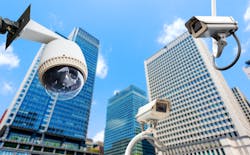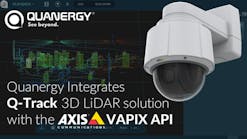In 2013, IHS Inc. (NYSE: IHS) announced that HD video surveillance was generating an astonishing 413 petabytes of data a day. By 2015, that number had jumped to 566 petabytes – the equivalent of 11.3 million standard double-layer Blu-ray movie discs.
Today, even more massive amounts of video are being captured with higher resolution UHD and HD cameras equipped with intelligence to enable highly detailed information analysis. Now trending under the category of “Deep Learning,” intelligent audio and video analytics solutions are being used to identify and notify systems operators of abnormal activities to provide predictive analysis.
Following are some of the current technologies for analyzing captured video data and, by doing so, impact the design and application of today’s more advanced surveillance solutions.
Tampering Detection
In television shows and movies where the storyline revolves around some criminal activity, it’s common to see the thief spray paint the lens of the video surveillance camera in order to mask their activities. In reality, intelligent cameras can detect lost vision due to the lens being covered or the focus adjusted. Even slight changes in camera direction caused by wind or vibration can be detected with tampering detection technology, causing an alarm to sound. Cameras can be programmed for various monitoring environments including defining minimum detection time until sounding an alarm.
Face Detection
Face detection is a technology which identifies human faces by comparing captured images against an image data bank or watch list of known/wanted individuals by identifying the key features of human faces. It requires a significant amount of video information which can be gained by collecting highly detailed video from user designated areas. This is done by customizing and configuring a detection area, exclusion areas, and sensitivity. Once detailed video is acquired from high-resolution cameras, one of three methods can be used for face detection.
The template matching approach develops templates based on facial information extracted and registers the relationship in the system. It then calculates the similarity between faces in video images and the templates. A feature variant approach utilizes facial features which are less influenced by rotation, size, and lighting changes. It combines information about eyes, noses, and mouths to determine the presence of a person's face. The boosting approach utilizes basic patterns of faces which are compared to a classifier containing facial feature information for determining an individual's face. The accuracy of these facial recognition technologies continues to improve with today’s high-resolution cameras ability to capture extreme details even under challenging conditions.
Intelligent Video Analysis
Security operators are responsible for monitoring video images from an average of 20 or more cameras. Viewing this many monitors and cameras simultaneously is ineffective and prevents operators from focusing on core monitoring duties, which can lead to an increased probability of missing critical situations due to viewing fatigue. A primary benefit of video analytics is that it helps to alleviate the problem of operator fatigue by automating the process to detect unexpected movement or unusual behavior that may pose a threat. Leading video analytic solutions include virtual line crossing detection; enter/exit detection; intrusion detection; appearing/disappearing object detection; and loitering detection.
Intelligent video analysis can also be utilized during recording and search operations, where recorded events are tagged with the event type and associated metadata. An operator can simply search recorded video for specific event types to quickly locate an incident, saving valuable time.
Audio Detection
Audio detection is a technology that detects sound levels which exceed the user-defined levels. As sound levels are typically greater in abnormal situations, audio levels exceeding set parameters are detected as being an uncharacteristic situation requiring further review. Through audio detection technology, the camera’s audio sensor can detect abnormal sound levels, and then automatically notify operators via event signals so they can take suitable action.
Audio detection can be further classified by source. For example, a gunshot can be detected by a camera located on a city street. In this instance, the camera features an audio source database which supports the classification of screams, gunshots, explosions and crashing glass. This is most valuable when considering that the cause of the audio alert may be coming from outside of the camera’s field of view, further extending general surveillance event detection areas. When a sound is detected, the camera extracts the characteristics of the audio source using the camera's internal or externally connected microphone and calculates its classification based on the pre-defined database. It selects the audio source with the highest likelihood and automatically generates an event.
These are just some of the technologies in use today to assist operators in determining the circumstances of an event, and the list continues to grow. One of the reasons deep learning technology has progressed so far and so quickly is because of advances in cameras’ processing power combined with new developments in Graphics Processing Units (GPUs), which are taking intelligent audio and video analytics to an even higher level.
Manufacturers are developing cameras and storage devices that go beyond providing video analysis data to provide customers with business intelligence beyond the scope of traditional security and surveillance applications. With more powerful processing power available today and on the horizon, video surveillance systems will be capable of autonomously detecting and documenting an even greater range of activities for more applications. The advent of deep learning algorithms along with high-performance CPU and GPU computing can be expected to profoundly impact the next generation of physical security solutions.
One leading video manufacturer and has recently announced a partnership with NVIDIA, an AI developer, to collaborate on an intelligent video analysis platform that enables fast and accurate video analysis data. In addition, this new platform will integrate with various solutions from the vendor, including city surveillance, retail and traffic applications, etc. This will lead to the integration of advanced AI-based capabilities that further increase safety and security, and deliver a new and powerful source of business intelligence.
About the Author: Tom Cook is the Senior Vice President of Sales at Hanwha Techwin America.


